 |
| credit Temura |
 |
| credit Todd Marshall |
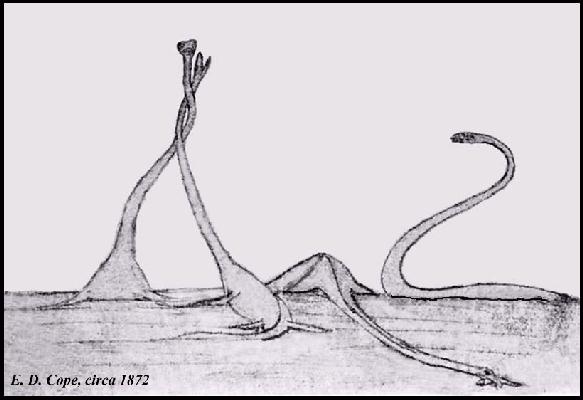 |
| credit Edward Drinker Cope |
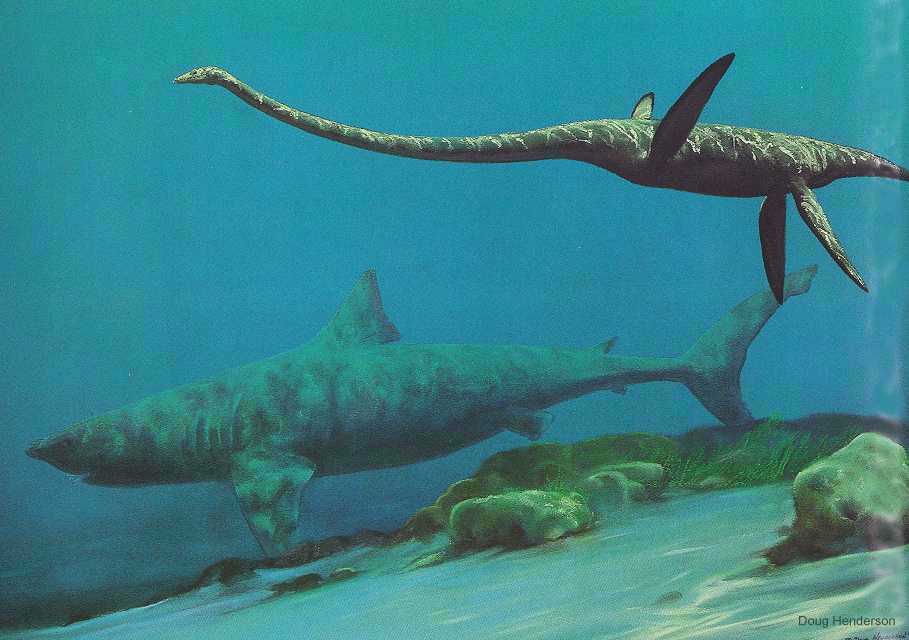 |
| credit Doug Henderson |
This post is on the tendency towards "shrink-wrapping" in plesiosaurs. As a quick explanation to those that are not familiar with the concept of shrink- wrapping in paleoart it is a noted tendency to highlight the skeletal framework of an extinct animal to the extent that the animal looks like skin draped over a framework of bone. As such it proves a bit of a disservice in communicating how real animals look with layers of fat, muscle, and integument largely obscuring the skeletal anatomy.
As I said earlier this artistic trope is quite noted with regards to terrestrial animals - especially theropods and sauropods - but here I want to argue the case that the depictions above shrink wrap plesiosaurs. But while they don't highlight the skeletal framework to the extent of much of what is classically regarded as "shrink wrapping" I will make the argument that the depictions above fall far short of the "girthiness" we should expect in such marine tetrapods.
 |
| (L) On the edge of life (R) prime of life credit NOAA Vancouver Aquarium |
Now above are some interesting shots taken via drone that capture an astonishingly gaunt killer whale on left contrasted with a healthy whale on the right. I am quite impressed that they can even get that skinny and survive in cold waters off of British Columbia. Unfortunately this whale on the left - which is fully extending its pectoral fins for lift as it is getting relatively denser and denser in the water due to fat loss - soon expired after this photo was taken. It looks so strange to us because you can make out the skull shape, vertebral column - these are features usually obscured by fat on these animals. We have grown so accustomed to the plump, streamlined shape of marine mammals that even the slightest visible hint of a skeletal outline makes them look quite alien. But even in declining killer whales the smooth, streamlined shape is so important that they will take on extra water in their body as they lose fat simply to maintain the nice teardrop profile. In this manner it is sometimes hard to spot declining killer whales until the rather sudden and rapid onset of the famished stage to the left.
Now this fat layer - blubber - is very important in not just streamlining the animal, but helps it maintain high intermal temperatures, achieve proper buoyancy, serve as energy reserve, sustain growing internal neonates, and shield the vital organs from predatory attacks. If we take a more broad scale evolutionary perspective an argument can be leveled that in the acquisition of an increasingly pelagic adaptation in marine tetrapods - developing a blubber layer solves an awful lot of problems and is a pretty easy step to achieve.
Why wouldn't plesiosaurs - which lived at high latitudes, dove deep, gave birth to large live young, maintained high constant internal temperatures, depended on erratic food supplies, travelled widely, and (most importantly) represented the longest tenure of any marine tetrapod ever - develop a blubber layer is beyond me. It is an inference, but it is one of the most parsimonious inference one can make about plesiosaur soft anatomy in my opinion. Certainly more likely than the Jack Skeleton plesiosaur so often times depicted.
For these reasons - unless it was the intent of the illustrator to depict them as gaunt and on the edge of death - I can't really take the above illustrations seriously. The Marshall illustration in particular shows bony protuberances galore while the Henderson Elasmosaurus - and I hate to say it because I love me some Henderson art - suggests such a flimsy, gaunt, Nightmare Before Xmas styled animal that, in my opinion, is outside the bounds of Darwinian evolution. As far as the other two illustrations go they do not necessarily show a bony countenance they just neglect any suggestion of blubber or musculature. Animals, especially active pelagic predators, just don't look like that.
Nope if you want to look towards an animal that serves as a good model for general plesiosaur appearance one can do a lot worse than looking at leatherback sea turtles, Dermochelys coriacea. These deep diving, temperate to subarctic ranging, endothermic, flipper propelled mega reptiles should be your go to animal for drawing and imagining plesiosaurs. And they are blubbery - with fat rolls all over the place. Just look at the guy below, it's like all of his double chins combined to form one mega chin!!
 |
| A blubbery reptile: Leatherback Sea Turtle (public domain) |
So I would say look more towards Jabba the Hutt as opposed to Jack Skeleton when thinking about plesiosaur soft anatomy.
I really get a kick out of the above video. A Stellar sea lion - probably pilfering fish - got caught up in the netting of a large Siberian fishing vessel. Both a hominid and a canid are tossed around like rag dolls by the powerful pinniped after getting to close and not showing the proper respect. I guess they never got the memo that pinnipeds are in fact large, powerful carnivorans. Stellar sea lions, the largest of the sea lions, are basically swimming grizzly bears. And constantly pushing, twisting, and rolling against a medium that has weight and resistance to it (i.e. water) is going to make actively swimming animals very strong all over their entire body in ways that terrestrial animals simply don't get. Tremendous trunk and vertebral muscles are what allow the pissed of Stellar to rag doll that fisherman.
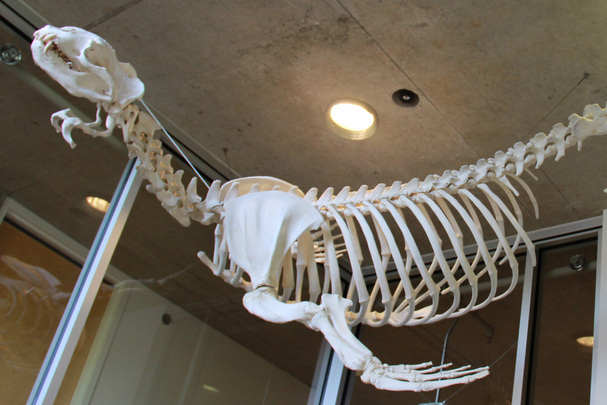 |
| UBC Stellar Sea Lion |
Note strong attachments for muscles in the neck and especially those dorsal processes that allow such power and also the large muscle attachments on the scapula that anchored the main propulsive organs - the front flippers. If you look at plesiosaur skeletons you can see in most species - especially elasmosaurids - a similar trend of high dorsal processes anterior and superior to the forequarters is evident. This area - also coincident with the center of gravity - would have been the veritable seat of power in these animals from which they could change direction, death roll, and manoeuvre.
 |
| trunk of Morenosaurus. LACMNH. Duane Nash |
If anything the dorsal processes are relatively larger in the above Late Cretaceous elasmosaur of California Morenosaurus than in the Stellar sea lion and are suggestive of relatively greater power along the entirety of the trunk and neck than the sea lion. Which brings me to the neck itself which is almost perpetually illustrated as a pea string, slender organ. I think this is a mistake. Although musculature was heaviest at the base it continued along the whole of the neck to the head. A neck that may have weighed one ton or more, that stretched up to twenty feet, anchored by powereful musculature? The neck was not a weak point and so easily severed by megapredators as so often depicted. Towards the base it was like a tree trunk but even towards the head was probably about the thickness of a good sized anaconda.
 |
| Hydrotherosaurus c/o Adam Smith/Plesiosauris.com |
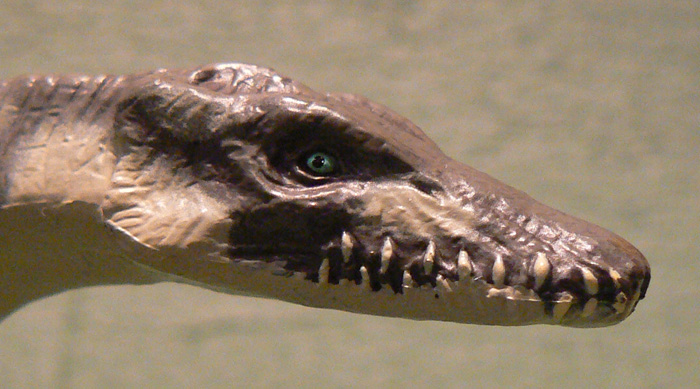 |
| Incorrect "Sunken Temples" Plesiosaurus. credit Dinotoyblog |
As for the head itself don't give it sunken temples. Instead I refer you to pictures of male California Sea Lions - draw the head a bit like a "knothead". "Knothead" is the less than affectionate term given to belligerent, large male CA sea lions by fishermen here - especially those that take up dock space or pilfer fish. The "knothead" term refers to the distinctive crest or bump on the top of the adult males' heads formed of muscle and fat. Plesiosaurs, especially elasmosaurids, seemed to increase the size and leverage of the temporal jaw closing muscles - which likely formed a visible hump or bump on the backside of these animals heads.
 |
| CA Sea Lion "knothead". credit Point Lobos Fndtn. |
But maybe even more so than "knotheads" look at the heads of large constrictors, or maybe even more appropriate large conger eels (great video on fishing for congers with great death roll footage). Both sport impressive temporal bulges for jaw closing muscles that were probably likewise apparent in plesiosaurs.
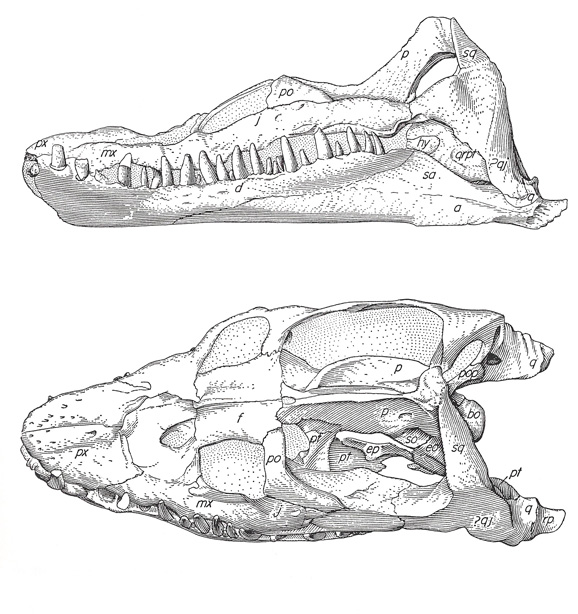 |
| Welles (1962) Callawayasaurus c/o Adam Smith. Plesiosauria |
 |
| Conger Eel. credit Totally Awesome Fishing |
And also for reference large boa snakes might offer some utility in plesiosaur heads:
 |
| Autopsy Boa Constrictor credit nadja & Sascha moresnakes.com |
 |
| Anaconda head. credit unknown. reptile forums |
And with those animals in mind - sort of a mashup of conger eels, sea lions, and large constrictors - put all that over the hypothetical skull of Morenosaurus and have some nightmares.
 |
| Hypothetical skull Morenosaurus LACMNH. Duane Nash |
So with robust heads, necks, and forequarters we now come to the torso which is essentially a sold base of bone and muscle. Seriously the robust skeletal framework of the torso with ribs, vertebrae, gastralia, pectoral and pelvic girdles is essentially like a "hard" internal shell serving as potentially protection for the vitals but a solid pectoral and pelvic girdle attachments for the muscles that powered the fore and hind flippers. And unlike sea lions, penguins, and sea turtles plesiosaurs were powered by two sets of flippers and thus doubly powerful in the torso. Long and short the torso was robust, powerful, and impressive. Artists should take note of the impressive forequarter regions of sea lions and leatherback sea turtles when depicting the fore and hindquarters of plesiosaurs but remaining cognizant of the distinctive possibility of a blubber layer further increasing the girth. Make 'em thick and don't apologize for it.
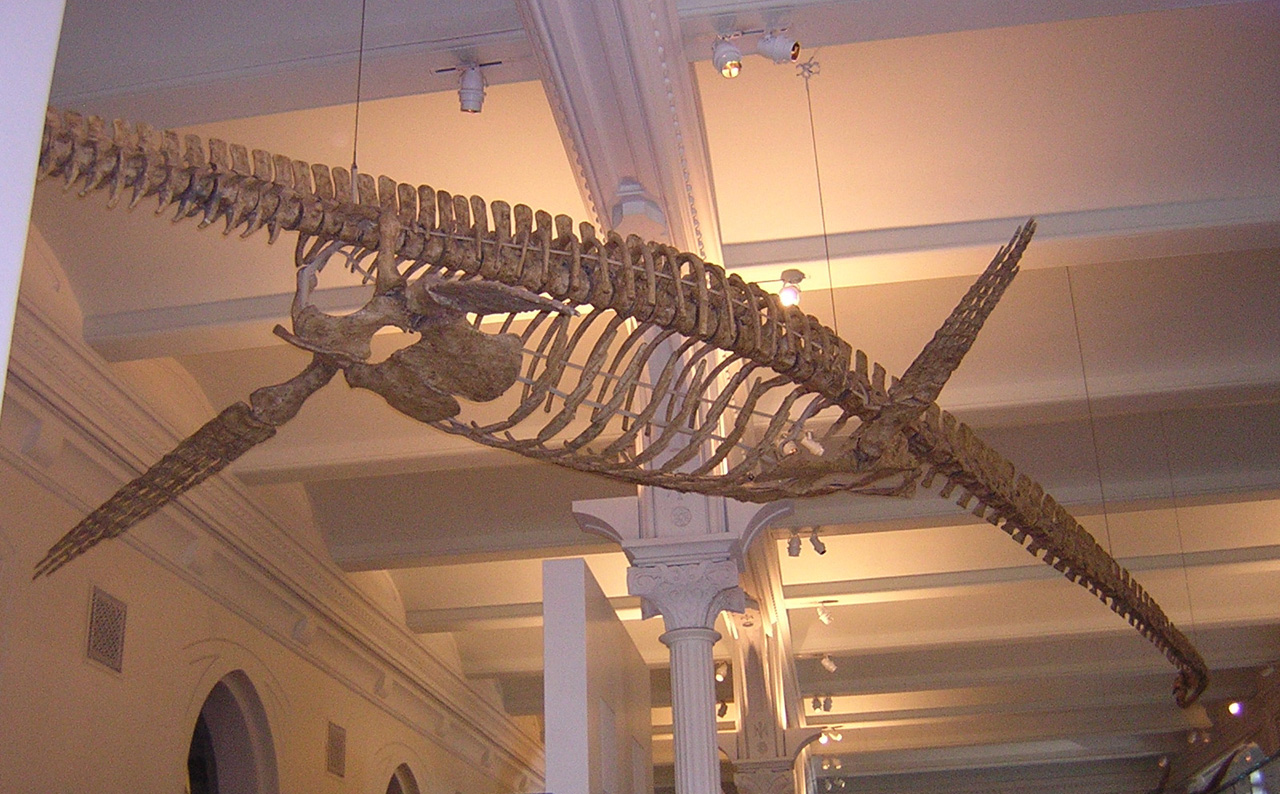 |
| Oblique and ventral view of Thalassomedon. credit Adam Smith plesiosauria. Note pelvic & pectoral girdles |
And finally, last but not least, is the tail. Now I know it has become in vogue to illustrate plesiosaurs with a little tail fin - and some likely had such a device especially the more pursuit/fast cruising varieties. But I doubt the utility of such a tail in most plesiosaurs. And when actually looking at the tails of some plesiosaurs, such as in the Morenosaurus I photographed below the tail looks downright "chunky". Now I keep hearing whiffs of plesiosaur remains showing flesh outlines of the body and the tail forming a seemless transition into a veritable "skink" like fleshy stump. And I like that idea, it could store fat and also act as a bit of predator lure. Here instead of my vulnerable distal neck and head bite onto my plump tail. It would be neat if some could shed their tails like many modern lizards, but that's a bit of a stretch. I wouldn't be surprised if the Mesozoic seas were not full of plesiosaurs with mangled/bitten/ slashed tails.
 |
| Tail Morenosaurus. LACMNH |
 |
| Shingleback Skink Tiliqua rugosa. wiki |
So there you have it: why you should give plesiosaurs "knotheads", thick necks, sea lion forequarters, sea turtle torsos, and shingleback tails. Give 'em the thickness.
Cheers!! Viva La Revolución plesiosaura!!
Support me on Patreon.
Like antediluvian salad on facebook.
Watch me on Deviantart @NashD1.Subscribe to my youtube channel Duane Nash.
My other blog southlandbeaver.blogspot.



7 comments:
I'm really enjoying your thoughts about plesiosaurs and am planning a few reconstructions based on your writing. Fantastic stuff... thank you!
A really interesting post, and I definitely agree with you about the shrink wrapping! Also, those killer whale pictures (and the link) are fascinating.
Alex.
Fantastic post as usual, Duane.
Also, congratulations to have been cited on the Dinosaur Mailing list! Ben Creisler reports of the famous chubby-tailed Mexican polycotylid, which I totally forgot about it. So we already have the proof of fat-looking plesiosaurs.
Still, even if that discovery is incredible, I've never been able to find any pictures of the specimen, have you?
Thanks for above comments. I am glad people are interested and the posts are sparking thought - that was my intent.
@davidmass Your welcome. Let me knew when you are done and I will post the pics here if that is ok.
@ Alex L. Yeah isn't that famished orca weird looking? especially those comparatively huge pectoral fins out stretched. It must be an agonizing death for such long lived, intelligent top predators. I mean with no other predator strong enough to come take you out they just slowly deteriorate, lose blubber, and it becomes a battle of attrition as they work harder and harder to get to the surface.
@Elijah thanks. No I have never seen anything as far as a specimen.
Come on, please continue so I can respect elasmosaurs as predators to be reckoned with and not as food for all other predators.....
Truest me you will like the next post Bk Jeong.
Dude, I bet you were strutting your stuff after the Mauriciosaurus paper came out. That critter is a tank.
Post a Comment